If I was going to have a tattoo of an important date, I might choose the day I met Mr Walker, the day my daughter was born or May 1966. Now, for someone not born until 1973, that might seem a bit of an odd one, but that was when the V&A held their extremely important exhibition on Aubrey Beardsley. Yes, yes, people had been talking about Victorian art before then and many of my favorite books on Pre-Raphaelitism predate this point but somehow after this date, it became legitimate to not only like the Art Nouveau/Pre-Raphaelite/Victorian of it all but also openly flaunt your proclivities in public without fear of recriminations. After this date, Victorian-ness hit the mainstream, reflected in 1970's Carry On Loving, which had an Art Nouveau poster on the wall of the hip and swinging flat. All of this rambling is by way of explaining how I ended up with a haunted Victorian child called Benjamin...
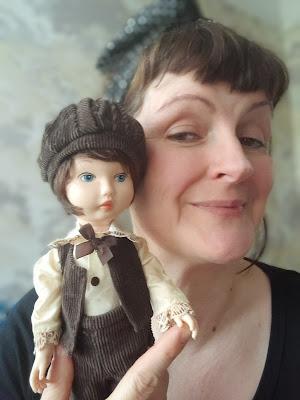
We'll come to my melancholic boy-child in a moment, but let me take you back in time...

Catherine 'Kate' Greenaway (1846-1901) is probably one of those book illustrators that has exceeded their era and remained in the public consciousness. Rather like Beatrix Potter, Kate Greenaway and her winsome Regency children in their rational dress sum up a certain side of Victorian England which isn't exactly mainstream but also very much how we now visualise the nineteenth century. Daughter of an engraver, Kate learned her skills at the schools of South Kensington, Heatherleys and the Slade, before launching her career with greetings cards and book illustrations in 1871, and her 1879 book Under the Window cemented her reputation as an artist of the idyllic and aspirational Victorian artistic childhood. She died of breast cancer in 1901, aged only 55.
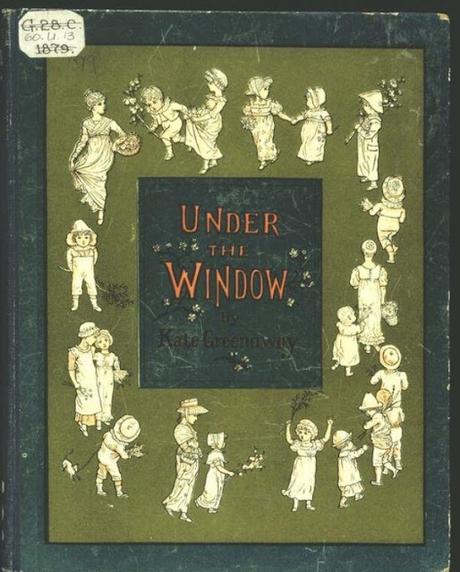
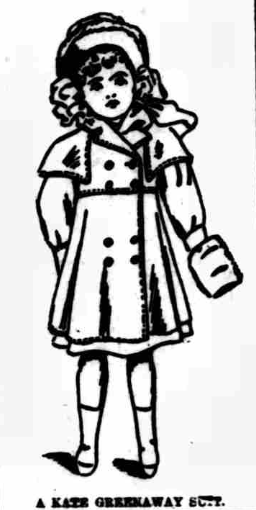
from North Eastern Daily Gazette, 1909
When an artist dies, there usually is a bit of a kerfuffle over how much they were loved and will be missed etc etc. In 1902, around two months after Kate's death, there was a retrospective at the Fine Art Society in New Bond Street, where the newspapers talked about her merits and how Ruskin had been a supporter and champion of her talent. After that, Kate Greenaway became synonymous with clothing, especially that of children and her career as a style icon really came into its own. I think the fact that her books remained in print possibly fueled this trend for kid's clothes but maybe it was a self-pollinating plant with the children's clothes resulting from the books, then the books being popular because of the fashion.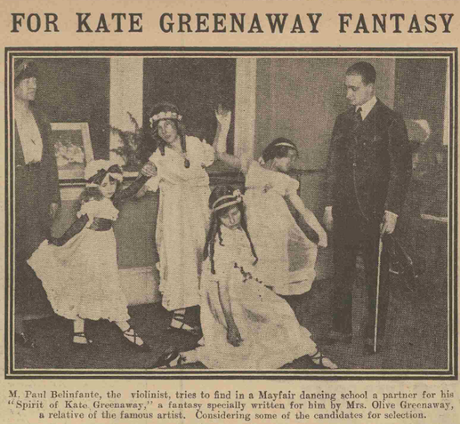
In 1921, Mrs Olive Greenaway, playwright and author No Winkles (you heard me), not to mention 'a relative of the famous artist' and in no way riding on her coat-tails, wrote the play Spirit of Kate Greenaway which, considering the picture above, involved lots of bendy girls dancing in high-waisted dresses. The London Daily News reported that Olive wanted to elevate her beloved relative to more than merely 'poke-bonnet' fame. It has to be said that she did just that and made Kate famous for not just bonnets but also the most fashionable wedding attire that the 1920s could offer. Going through newspaper reports of the 1920s, there are numerous society weddings where the little poppets acting as flower girls and page boys had the dubious pleasure of being in velvet or white satin (imagine how long that remained white...) The Pall Mall Gazette of June 1923 reported that Peggy Marter married the astonishingly-named Roualeyn Gordon-Cumming and had a little boy and girl as attendants, each dressed in Kate Greenaway suits of green and white. The Daily Mirror reported in April 1926 that Joyce Philipson and Terence McKenna had three little Kate Greenaway bridesmaids following her.

from Marigold Garden (c.1892)
Celia Weigall and Captain Humphrey Noble had six bridesmaids in blue satin with wreaths of forget-me-knots and a page in blue satin, all little Greenaway moppets in January of the same year. Closing the decade, Elizabeth Howell married Frederick Pill, accompanied by a bevy of bridesmaid and pages in lemon satin Kate Greenaway style outfits. Finally, and I have to add this one because the bride was called Betty Shove (awesome) and Miss Shove married James Rose with bridesmaids dressed in primrose satin and matching bonnets. This was backed up by the reprint of what was referred to as the 'Kate Greenaway Birthday Book' taken from her Almanacks, mid-decade.
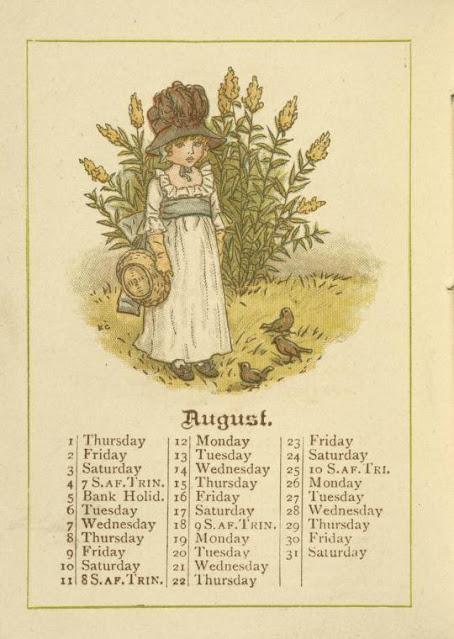
August from the 1889 Almanack
If anything, the 1930s were even more densely packed with Greenaway-inspired events. Possibly the most touching was a party at Acton hospital at Christmas 1938. The tables were decorated with Greenaway themed dolls and all the patients in the women's wards wore bonnets inspired by her art. I see that newspapers even offered paper patterns to make fancy dress costumes that meant a child could dress as 'Kate Greenaway' (No.23 from the West Sussex Gazette paper pattern dept in 1932.) It's that curious? I can't think of another artist where you'd say that, for example you wouldn't sell a 'Bubbles' costume and call it a 'John Everett Millias' costume because although you might call it a 'Millais' costume, by calling it by the artist's full name, it implies that that is what they looked like. I wonder if by 1939, people assumed Kate Greenaway was a woman who wandered about in an Empire-line dress and poke bonnet.
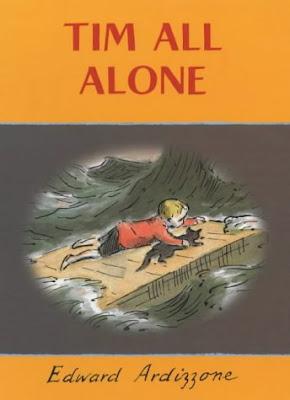
Okay, this is all a long-winded way of getting to the 1970s, but hang in there. Kate's dominance was seemingly cut short by the Second World War, cutting newspaper mentions from almost 4000 in the 1930s to 580 in the 1940s (yes, I know, other stuff was going on that decade) and not even her centenary in 1946 really made much of an impact. In 1955, the Kate Greenaway Medal for children's illustration was established, the first winner being Edward Ardizzone in 1957 for Tim All Alone. I'm a bit disgruntled that the medal's name was changed in 2022 to the Carnegie Medal (I think rolling together two different medals but keeping the name that wasn't a book illustrator, which makes perfect sense apparently). So, all was quiet with the odd reissue, but the 1960s changed everyone's attitude to the Victorians. It seems to me, as someone not born yet, that there was a polarisation of opinion (which arguably still exists) as to the worth of all things Victorian. Into the 1970s and in the summer of 1973, Penshurst in kent held an exhibition of Kate Greenaway books, cards, original drawings and the almanacks which proved to be very popular and more to the point, commercial...
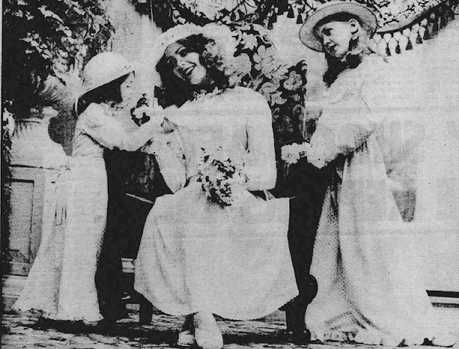
'Storybook Bride' from Sandwell Evening Mail, 1979
It was like the 1920s all over again, and weddings were again filled with Victorian bridesmaids; In 1975, Country Life began to say 'Kate Greenaway' in the same breath of 'Laura Ashley' and that country idyll took on a new aspect. Laura Ashley, who had been printing Victorian scarves since the 1950s and selling clothes since the 1960s finally became mainstream in the 1970s. Edith Holden's Country Diary hit the shelves in 1977. Arguably, Kate Greenaway's style is not the same, far simpler, but in rediscovery I guess we don't concentrate on the fine details, just that Kate was a Victorian and her pastoral perfection fitted in with the aesthetic.
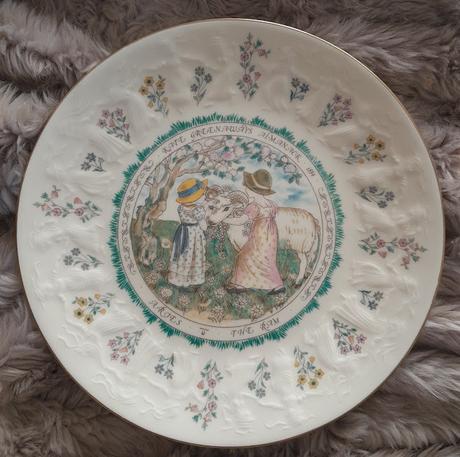
My Aries plate...
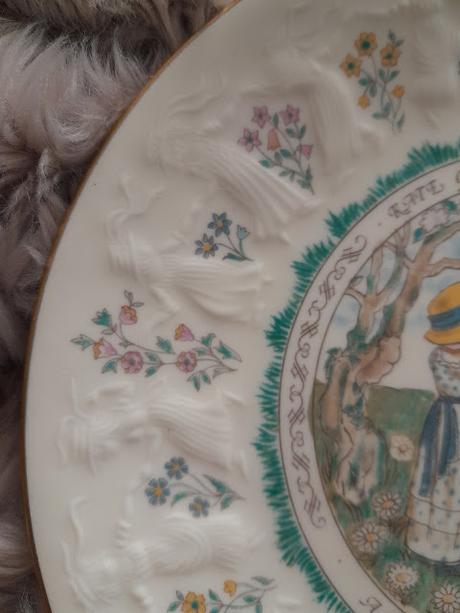
Detail of the dancing girls

Reverse of plate
Within this came some interesting off-shoots. In 1979, Royal Doulton produced a set of 12 plates decorated with Kate Greenaway illustrations. These were promoted in the Staffordshire Newsletter for Mothering Sunday - 'If Mum likes to collect small pieces of china, Royal Doulton of Stoke have some lovely pieces. You could choose a Kate Greenaway plate with Mum's own zodiac sign.' These have embossed dancing figures around the outside and on the reverse were notable events that occurred within that zodiac month and are based on her famous 1884 Almanack.
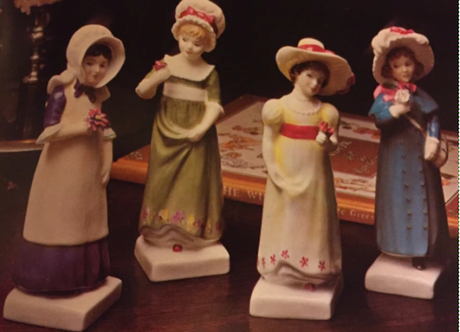
These followed the 1976 range of figures, sculpted by Peggy Davies, which continued to be produced until the late 1980s. I find these to be more traditionally Victorian in color if not style, rather than the pastel, white and green Regency children that I associate with the Greenaway look. They also produced Peggy Nibet's range of Kate Greenaway dolls followed in 1981 (see this website for a full range)...
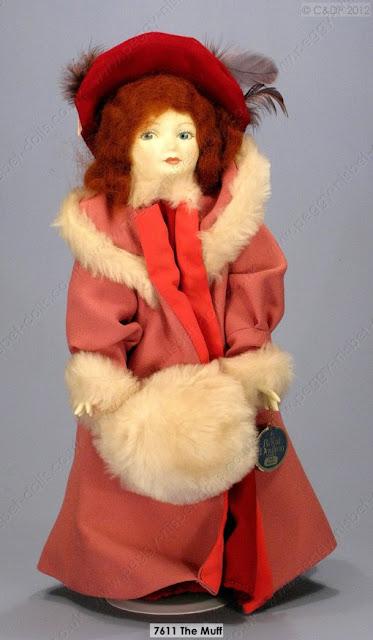
Of course I picked 'The Muff' as my illustration
These were limited addition and all very much aimed at the collector, but by accident I found a range of Kate Greenaway merchandise that was actually aimed at children. That is how I acquired my haunted Victorian son. Say hello to Benjamin...
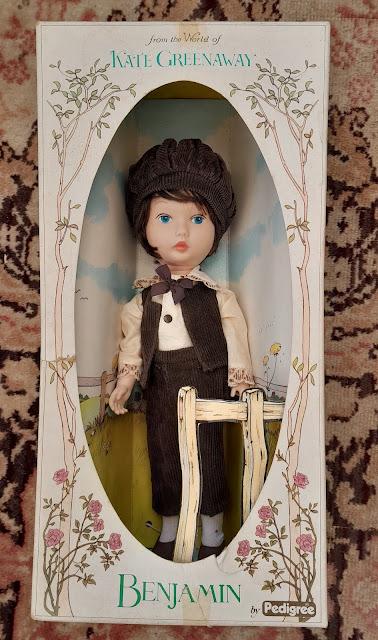
Benjamin in box
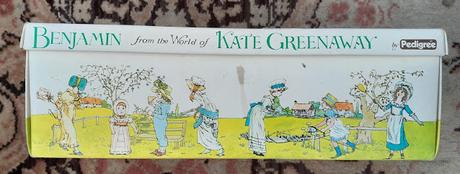
The side of the box
Yes, I am aware that one night I'll wake up and his little chubby face will be looking down at me, but I feel fairly certain he is not actively plotting against me. The reason Benjamin and I met was that I collect 1970s and 80s Pedigree Sindy dolls. In one of my endless eBay searches for 'Pedigree doll' up came this moppet and his equally haunted siblings, Charles, Meg, Nell and Constance. Standing 12" (apart from Constance who is a big 15" girl), they fed into a nostalgic doll trend which can be seen in ranges such as Holly Hobbie who had her 1976 Knickerbocker doll. Many, many thanks to the wonderful Annie of Our Sindy Museum for further information - Kate Greenaway was a keen doll collector herself, so it seems natural that there would end up being dolls of her figures. The dolls had twisting waists and the normal five-points of articulation, although I noticed Benjamin has a ball-joint neck like Sindy which means he can tilt his head. He, Constance and Meg are dressed in brown cord, whereas Charles and Nell wore blue and green. Most intriguingly, the boxes were beautifully illustrated with Kate Greenaway illustrations and the doll stands within a scene, possibly hinting that, despite being what we would call 'playline' now, there was a collect and display aspect to the dolls too. When the dolls launched in 1977, the Liverpool Daily Post were intrigued: 'an interesting face of the doll scene is the revival of period dolls. The biggest venture of this kind is the Kate Greenaway range by Pedigree, but other firms are also putting their money on map [sic]caps and flounced bloomers.' They cost around £4, the same as a Ballerina Sindy doll and was heavy pushed as a Christmas present in 1978.
These were not a long-lived range, and despite being perfect age for these in 1978, I have absolutely no recollection of them, so they did not reach my corner of Wiltshire. By1979, the Big Store toyshop in Nottingham was advertising them for half price and there remains only the five which can be purchased on eBay should you need a melancholic poppet in your life too. I don't think I'll be buying any more of them, as although I don't want Benjamin to be lonely, I don't want to be outnumbered by them.
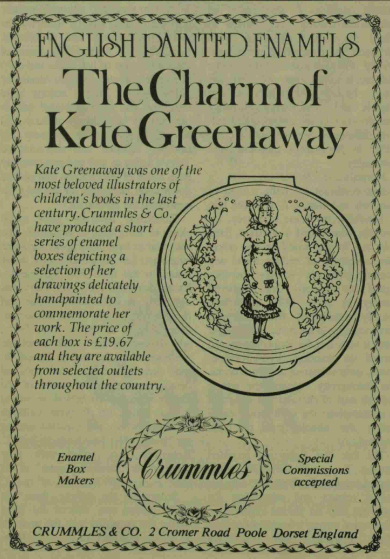
from the Illustrated London News, 1980
The 1980s brought more china knick-knacks, but the mention of her name was invariably followed by the word 'medal' and she slipped back from the public consciousness. Now, if you asked someone what Kate Greenaway meant to them, I'm guessing they would talk about her books rather than a wedding they had been to or the china figures on their mantel piece. So, is this a good thing? Shouldn't we celebrate an artist becoming larger than their art? For a time during those electric-boogaloo years of the 1970s, kids knew who Kate Greenaway was and had examples of her art in their rooms. Despite not having the dolls, I had the 1970s reissue of Under the Window by Picture Lions so Kate was in my consciousness. I am happy to die on the hill that it is okay to pander to kids in the name of art - when I helped the National Trust produce a children's wombat trail around the Red House, I wanted to make kids feel happy about art. Did that teach the kiddiwinks about the finer points of William Morris's socialism? No, but maybe in time they will feel confident enough to find that out because they will know Morris and feel that he and his art and everything else is for them. Likewise, not every child who owned Benjamin, Nell, Meg, Charles or Constance became an art historian, but for that time they knew and treasured a byproduct of the intellectual property of a female artist who had been dead almost 80 years.
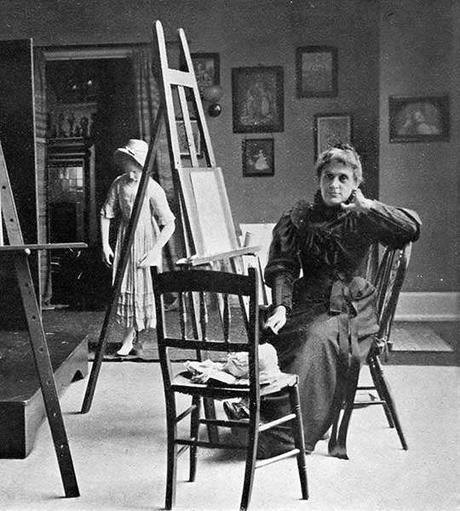
Kate Greenaway in her Studio, 1885
Of course I'm calling for a retrospective. And so is my son, Benjamin.

